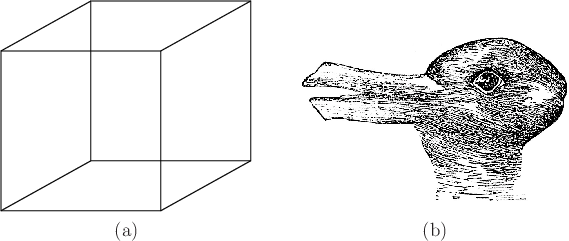
Next: McGurk effect Up: 6.4 Combining Sources of Previous: 6.4 Combining Sources of Contents Index
 |
In some cases, our perceptual system may alternate between two or more conclusions. This is called multistable perception, for which the special case of two conclusions is called bistable perception. Figure 6.26(a) shows two well-known examples. For the Necker cube, it is ambiguous which cube face that is parallel to the viewing plane is in the foreground. It is possible to switch between both interpretations, resulting in bistable perception. Figure 6.26(b) shows another example, in which people may see a rabbit or a duck at various times. Another well-known example is called the spinning dancer illusion by Nobuyuki Kayahara. In that case, the silhouette of a rotating dancer is shown and it is possible to interpret the motion as clockwise or counterclockwise.
Steven M LaValle 2020-11-11